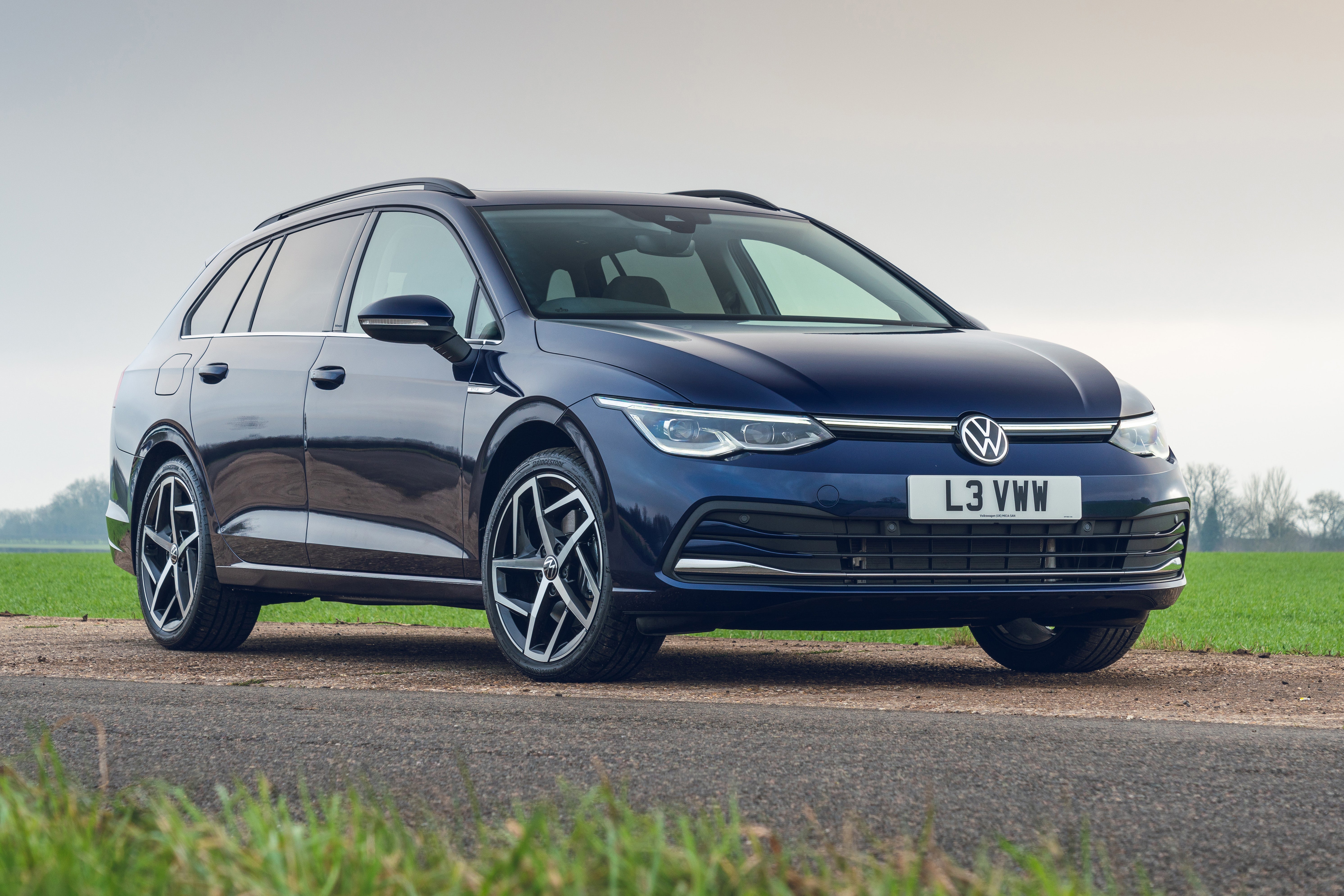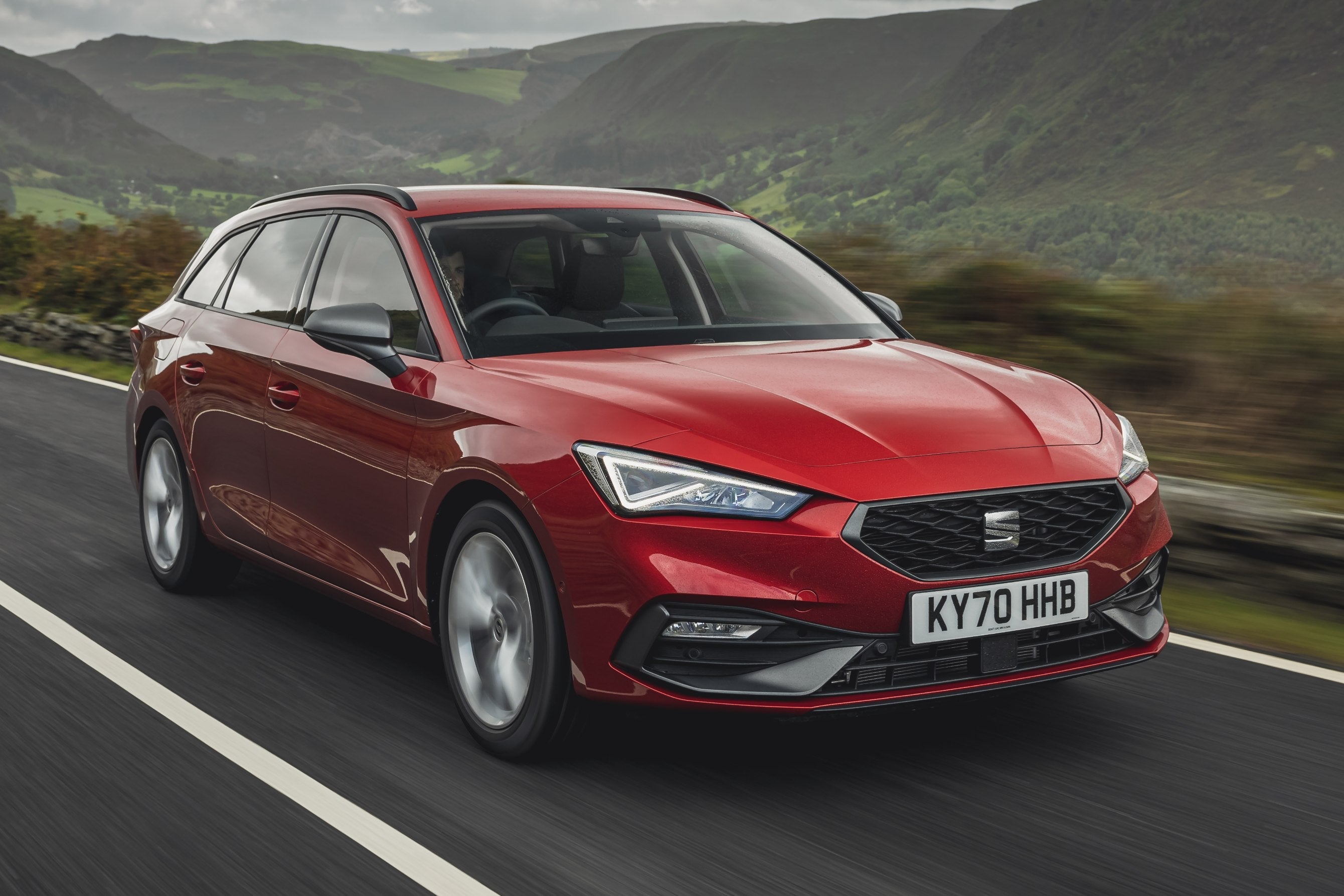Peugeot 308 SW Review 2023
Written by Lawrence Allan
Quick overview
Pros
- Distinctive design inside and out
- Plenty of kit and improved technology
- Comfortable and refined
Cons
- Boot space prioritised over passenger room
- Driving position won't suit everyone
- Hybrid could be smoother to drive
Overall verdict on the Peugeot 308 SW
"We like the new Peugeot 308 in hatchback form, so it shouldn't really be surprising that the SW estate gets another thumbs up in this review. We've reservations about the rear seat room, the hybrid's gearbox and brake response and whether tall drivers can make the driving position work, but overall it's a likeable addition to the family estate market with more desirability than most. "
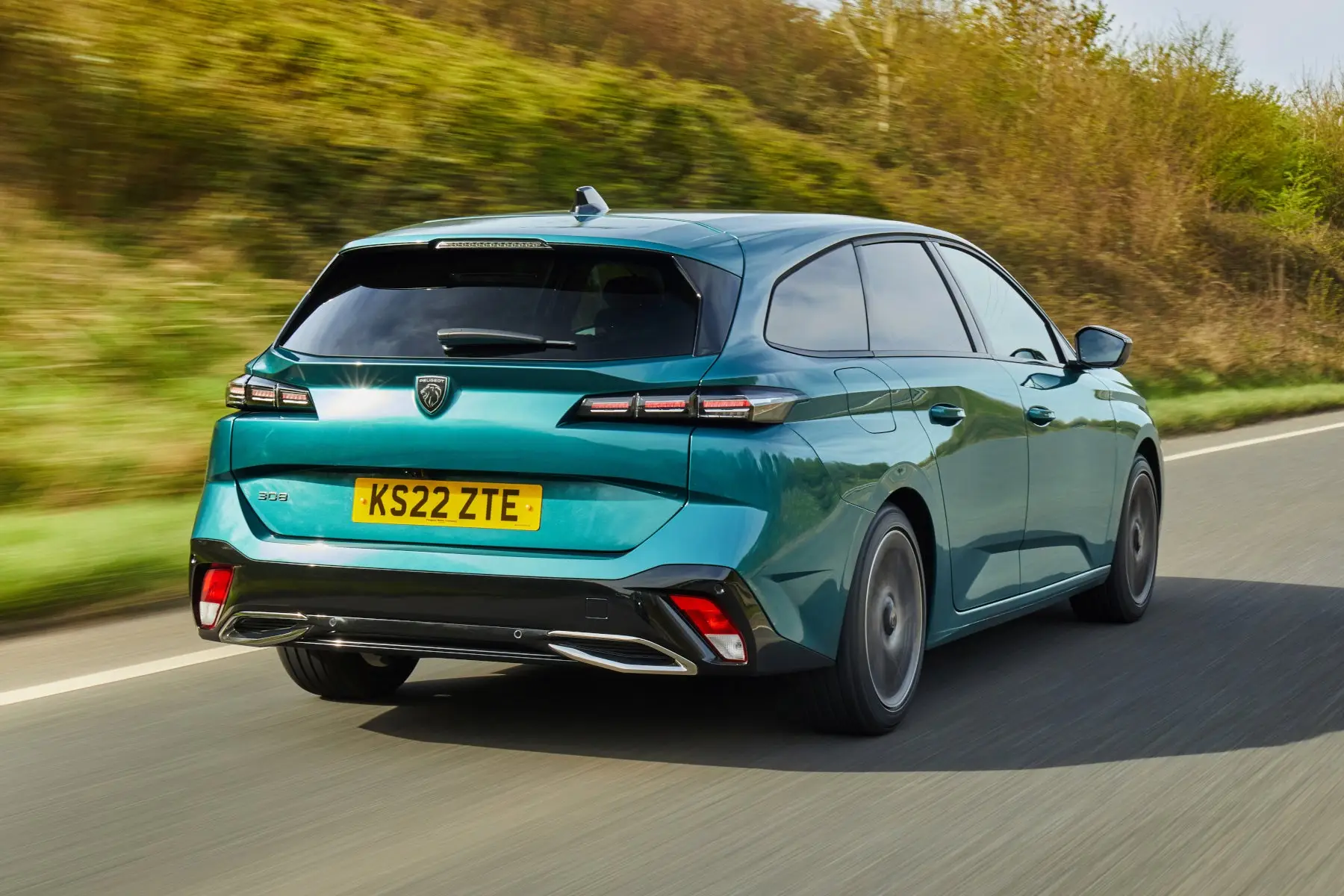
In the same way that pop artists have to reinvent themselves to stay cool as tastes change, estate cars have undergone an image revamp in the last few years as SUVs became the dominant choice for practical family transport.
That's why you'll find an awfully large number of estates that don't actually have 'estate' in the name these days. Many now have different variations of 'Sports Tourer', 'Wagon' or other designations, while the term 'Shooting Brake' has made a return as car companies look to give their load-lugging models a more fashionable image. Enter the latest Peugeot 308 SW - short for 'Sports Wagon'.
Like the old 308 SW it tries to blend practicality with a dose of style, with rivals such as the Toyota Corolla Touring Sports, the Renault Megane Sport Tourer and the SEAT Leon Estate alongside more rational, traditional estate cars such as the Ford Focus and VW Golf.
We reckon the new Peugeot 308 SW is the most overtly stylish and distinctive of the lot. Its complex shapes and surfaces might not be to all tastes, but it'll certainly stand out in the office car park, particularly if you're willing to be brave with the colour choice. In fact, the pert rear-end, chiseled tailgate and intricate tail-lights might make it prettier than the new 308 hatchback.
The interior, too, is an interesting place to sit with its angular shapes and varied surfaces. The new Peugeot 308 is closely related to the latest Vauxhall Astra, along with the more SUV-like Citroen C4, but it definitely has a more lavishly trimmed and elegant dash layout than either. Peugeot's i-Cockpit driving position certainly gives it a unique selling point - although it still won't suit drivers of all shapes and sizes. Quality is largely very good, too, with some posh materials even on lower-end trims.
Perhaps the biggest improvement over the old 308 SW, however, is the tech. Peugeot has introduced totally new, much improved infotainment with dual screens and novel customisation to allow easy access to commonly-used features. Indeed, the main downside of the cabin is now the mediocre rear seat space, which is only a little better than the old car and a fair way behind the class best. This matters more in an estate, although the boot is still a competitive size.
Still, the 308 SW redeems itself when it comes to the driving experience. We're already very familiar with the base Puretech 130 1.2-litre turbo petrol engine, but it remains a great offering even in the heavier estate, while Peugeot still offers a diesel engine for those who spend lots of their lives bombing down motorways. Purists may lament the lack of any manual offering - Peugeot's manual 'boxes were never brilliant, but it's nice to have the choice - although the standard eight-speed automatic does a respectable job.
Given so many Peugeot 308 SWs are shifted to fleet buyers, we expect the two new plug-in hybrid (PHEV) models will be popular. With 180 or 225PS they're not short of power, but the real draw is low emissions, low company car tax and (officially at least) the ability to travel up to 40 miles on a charge in electric mode. What's more, a fully electric Peugeot 308 is due next year with a range of 250 miles - it remains to be seen if this will morph into an estate, though.
On the road the new 308 SW offers a pleasant and composed driving experience, managing to be fairly enjoyable to steer around a twisty road while still offering good ride comfort and refinement. Granted, a Focus estate is sharper and more engaging, while a Golf estate is slightly better at isolating you from the sharpest bumps, but the Peugeot strikes a decent balance.
There are more affordable estate cars around if what matters to you is outright space and value. But the Peugeot 308 SW caters to a more style-conscious audience that is happy to pay a bit more for a striking design, a higher quality cabin and plenty of gadgets. If family buyers eventually decide that SUVs are no longer cool, expect the 308 to be towards the front of the prospective queue.
If you're looking for the previous version, you need our used Peugeot 308 SW (2014-2021) review.
Is the 2022 Peugeot 308 SW right for you?
The new Peugeot 308 SW is a good choice for family buyers who want something with a bit of pizazz rather than an anonymous-looking alternative. Those who appreciate technology, an upmarket cabin feel and comfort will be willing to spend a bit more over something like a Skoda Octavia, too.
It'll also be great for long journeys thanks to good comfort and refinement, yet its relatively compact size for an estate means it's easy to park and manoeuvre around town.
What's more, a big boot means those looking to carry lots of stuff are well catered for. However, that boot comes at the expense of rear seat space, which if fine if you're intending on carrying kids or average-sized adults but not ideal if you're regularly loading the back up with six-plus footers. Something like a SEAT Leon Estate or Skoda Octavia Estate would be much better in that respect.
What’s the best Peugeot 308 SW model/engine to choose?
For most people's needs we reckon the entry-level Puretech 130 petrol engine is the best choice in Allure trim. It might be the smallest engine but it doesn't need to be worked that hard to get you about, while it'll also be reasonably efficient. Even with the extra 50kg or so the 308 SW is carrying over the hatchback, it'll rarely feel underpowered.
If efficiency matters above all else, though, we'd be looking at one of the plug-in hybrid models. They're more expensive to buy or lease, but may make sense for private buyers because of the potential fuel savings on offer. It's worth doing the sums, though the extra power may be enough to justify it. Of course, fleet buyers will flock to the hybrids in their droves.
What other cars are similar to the Peugeot 308 SW?
Not every rival to the Peugeot 308 hatchback is available as an estate version, so for that reason the Honda Civic and Mazda 3 are out. As are premium rivals such as the BMW 1 Series, although Mercedes will sell you the style-focused CLA Shooting Brake.
Really, though, the 308 SW's key rivals are the estate versions of the Ford Focus, VW Golf and SEAT Leon, along with the Renault Megane Sport Tourer and Toyota Corolla Touring Sports. There's also the Hyundai i30 Tourer which isn't as style-led but is more affordable, while the Kia Proceed is definitely style-led and offers more space than you might expect. The latest Vauxhall Astra Sports Tourer (which is closely related to the 308) is not yet in showrooms, however.
Comfort and design: Peugeot 308 SW interior
"With a shapely dashboard and classy materials the new Peugeot 308 SW feels a cut above cheaper rivals. But the key improvement over the old model is the technology, which is cleverer but also more useable."
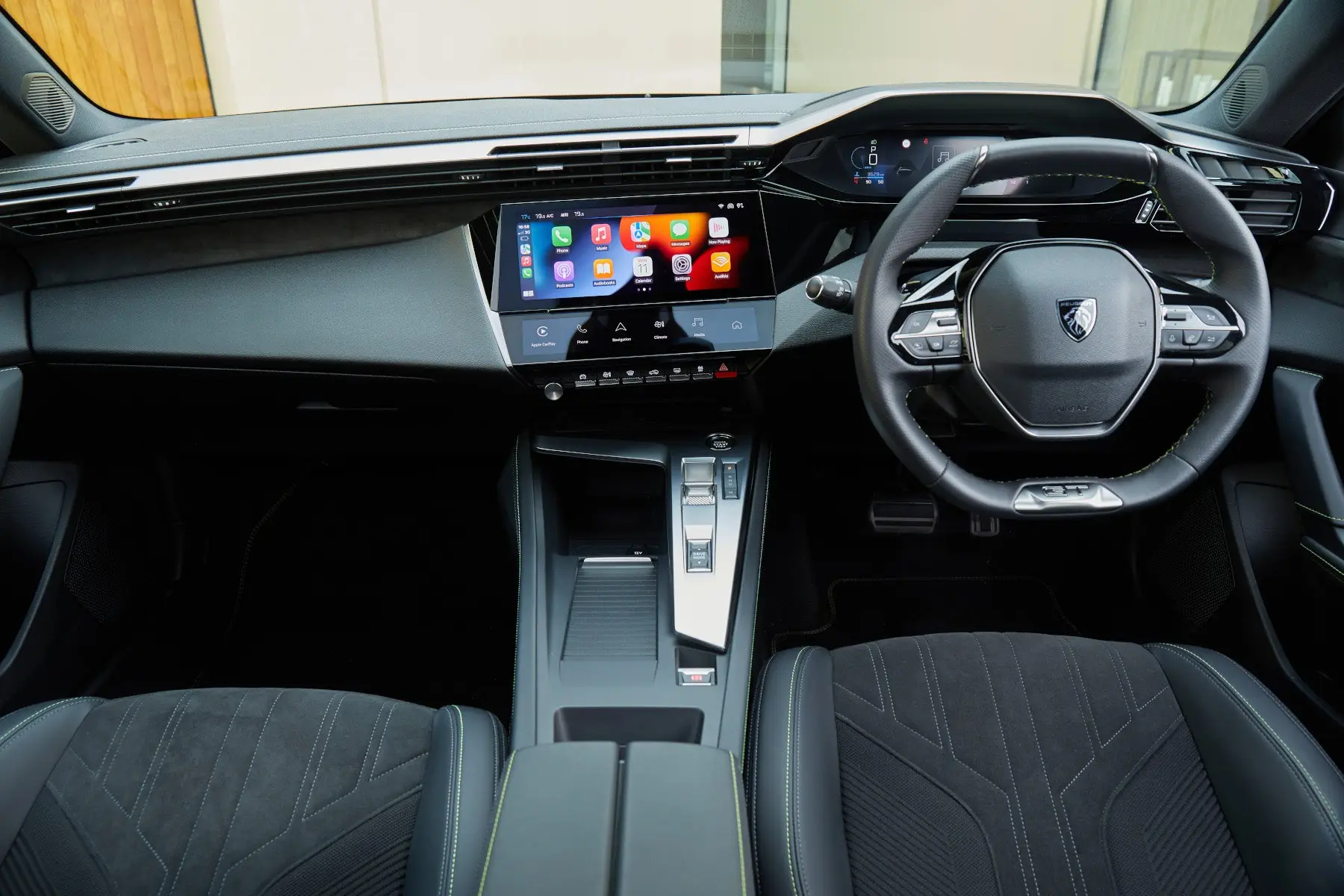
Step inside the 308 SW and you'll see why Peugeot wants to be considered as an 'upmarket mainstream' Stellantis brand. It all looks and feels a bit more Audi than Skoda inside, that's for sure.
The dash design is far from plain, with angular shape and a pleasing mixture of mostly soft-touch materials. Peugeot has avoided the now typical mass of gloss black plastic which shows up dust and fingerprints, although there is some on the wheel and the glossy surface of the touchscreens will still do this. All versions except the cheapest model get multi-colour ambient lighting, too.
Peugeot is continuing to use its 'i-Cockpit' driving position, which give you a small steering wheel and high-mounted digital dial display that you view by looking over the wheel, rather than through it as in most cars. Most drivers of average size will get on with it just fine, but this 6ft 3in tester found you still have to compromise between seeing the bottom section of the dials without leaning forward or having the wheel set low enough to be obstructed by your knees. It's worth trying it before you buy.
The little steering wheel itself is nice to hold, however, with the same quality feel as the rest of the 308 SW's cabin. Peugeot has avoided saddling drivers with fiddle touch sensitive wheel buttons, too, while you'll now find some easy to prod piano key physical shortcut switches at the bottom of the centre infotainment stack.
The touchscreen is noticeably larger than that of the old 308, with a more responsive and crisper-looking display along with menus that aren't too much of a minefield. In an effort the enhance usability Peugeot has also installed a second touchscreen panel below that display (standard on Allure trim and above) which features six shortcut widgets. You can change these to items you select most often, such as your favourite radio station or even your partner's number. The big icons are pretty easy to stab on the move, too.
Storage is decent on the Peugeot 308 SW, but not remarkable. The lack of a manual gearbox helps here. We do wish there was more outright space in the rear, however.
Quality and finish
Peugeot has spend several years trying to convince us it's a semi-premium brand, sitting a class above its Citroen and Vauxhall stablemates. Recent products have done a good job of doing so, and the Peugeot 308 SW continues that trend.
Fit and finish throughout the cabin is on a par with the latest VW Golf estate, which some materials actually feeling more plus than the German rival. The door grab handles feel solid, there's very few scratchy plastics and lots of squidgy trim, along with posh suede-effect and leather elements on the dash and doors. It certainly feels that bit more high-end than the class average.
Granted, poke around lower reaches of the cabin (such as the door pockets and glovebox lid) and you will find harder, less tactile plastics. But accepting what the Peugeot 308 costs, this really isn't a big deal.
Infotainment: Touchscreen, USB, nav and stereo in the Peugeot 308 SW
Whichever version of the Peugeot 308 SW you go for you'll find a bright 10-inch touchscreen in the centre of the dash. Paired with an identically-sized digital dial display on all versions, you also get a simple voice control system on base models.
We'd avoid the base Active Premium model, largely because you don't get the little second touchscreen below the main infotainment for the useful shortcut widgets. There's no sat-nav, either, which on other variants brings live traffic updates and speed camera alerts. Furthermore the voice control is more advanced from Allure spec above, and can be activated by saying 'OK Peugeot'.
Allure trim also gives you useful details such as USB sockets in the rear as well as the front. Wireless phone charging is an option, though it's standard on Allure Premium and above, as is wireless Apple CarPlay and Android Auto (it's wired on the two base trims).
The only further upgrade to the infotainment system is the stereo. All models get a six-speaker sound system, but plump for GT Premium and you get a Focal Premium surround sound system with additional speakers. It sounds pretty punchy, and is also optional on GT trim.
Space and practicality: Peugeot 308 SW boot space
In terms of exterior dimensions - for those that aren't over-endowed with parking space - the Peugeot 308 SW is 4636mm long, 1852mm wide excluding mirrors and 1450mm tall. That's around 270mm longer than the 308 hatch, but a little shorter than a Ford Focus estate.
We'll start with boot space first given thats kind of what estate cars are about, and there's bad news on this front: the new 308 SW's boot is actually smaller than the model it replaces, in capacity terms at least. It's down to 608 litres, from an unusually generous 660 litres of the old car - although with the plug-in hybrid models sapping the underfloor storage due to their battery packs that figure drops further to 548 litres.
Regardless, the fact that the standard 308SW's boot capacity figure begins with a six still means it's among the roomier cars in this class - you'll have no trouble with three of those giant, multi-week holiday suitcases, while a trip to that well-known Swedish furniture store should be no sweat. What's more, the capacity grows to 1634 litres when you fold the seats down, which is done easily via levers in the boot and allows a 40/20/40 split. With side hooks, nets and (on non-PHEVs) two separate underfloor storage compartments, it's all good back there.
Up front, too, there's plenty of headroom and decent cabin width, meaning you won't need to have an elbow war to access the centre armrest. The i-Cockpit driving position isn't suitable for everyone, though - the very tall will find they have to fix the wheel unnaturally close to their legs to fully see the dial display. We wish Peugeot wouldn't mount the pedals so close to the driver, as it would allow long legs to stretch out better.
More grumbles begin when you jump in the back, though. The old 308 SW has a ludicrously large boot but barely any more rear seat space than a supermini. Peugeot has traded a bit of the former for the latter, but rear legroom in particular still lags behind cars such as the Skoda Octavia estate - and in fact sits below the general class average, meaning six footers will have their knees wedged into the seat back.
Headroom is at least a bit better than the hatchback on account of the straighter roof, but it's still not brilliant. That's a shame, because we hoped for a bigger improvement. The rear seats themselves are comfortable, though, so smaller adults and children will be fine, while there isn't a big lump in the floor so the middle seat is fairly usable. Of course there's ISOFIX points back there for mounting child seats, too.
There's good news when it comes to storage at least: the new 308 is the first Peugeot of the 21st century where they've actually bothered to move the fuse box for right-hand drive cars, meaning it doesn't take up half the glovebox. There's decent door bins and a cubby below the opening centre armrest, too.
Handling and ride quality: What is the Peugeot 308 SW like to drive?
"The Peugeot 308 SW manages to nicely balance a comfortable ride with composed handling. Sure, it's not quite a class-leader in either respect, but as a compromise it's pretty good, while there's no weak link in the engine range."
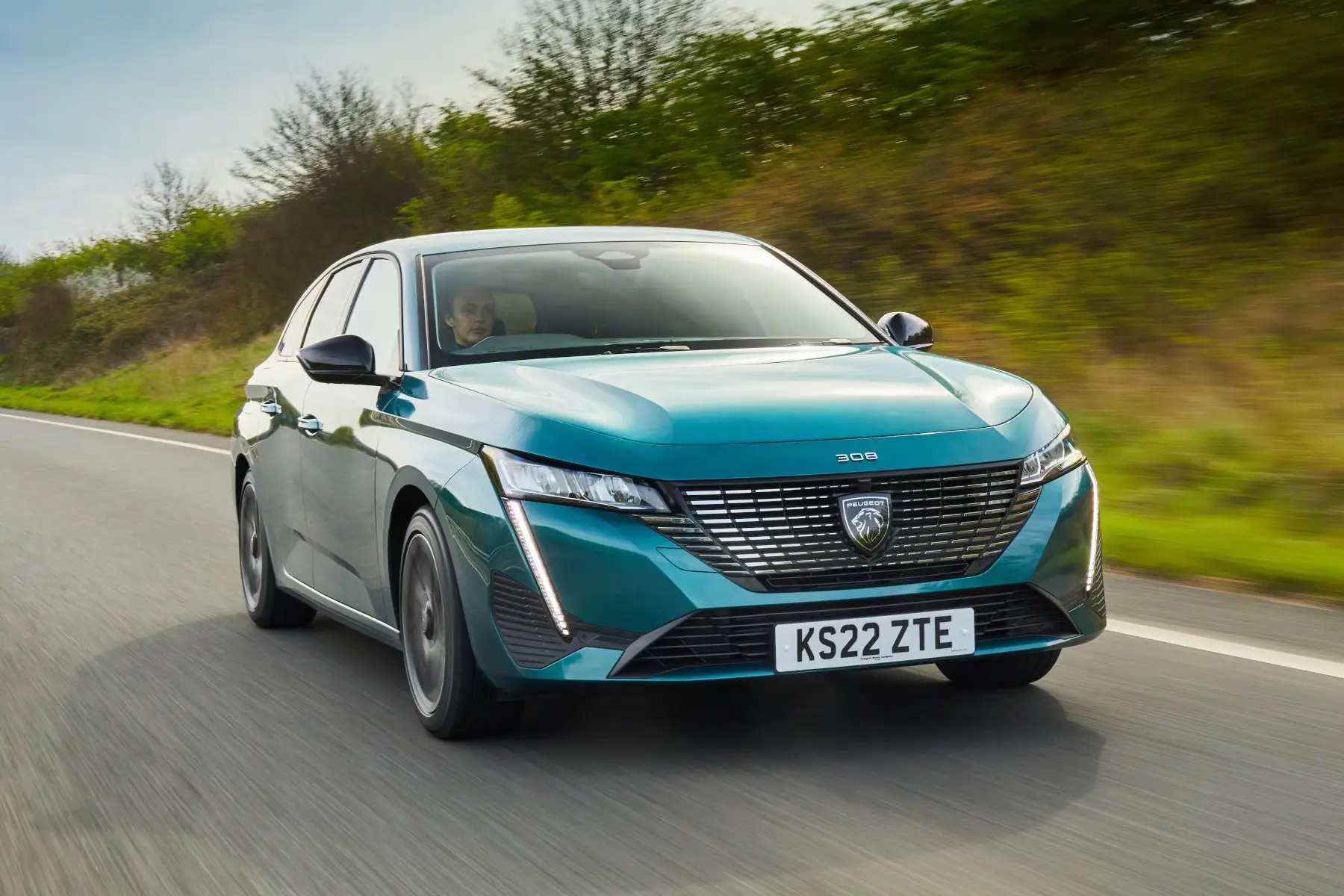
If you could draw a line right between the lolloping softness of a Citroen and the tied-down firmness of, say, a SEAT Leon estate, that's where the Peugeot 308 SW would sit.
The small steering wheel helps heighten the 308 SW's sense of agility, meaning it feels more keen to change direction into a bend than some rials. Combine that with a decent turning circle and it's a pleasant thing to drive around town.
Visibility looking forwards is good, and rearwards the SW seems to have thinner pillars than the hatch, but the rear window isn't huge. Thankfully even the base trim gets rear parking sensors, while mid-spec models get front sensors and a reversing camera, too. Move up to GT Premium and you get a full 360-degree camera display with self-parking assistance.
On faster, twistier roads you'd be hard-pushed to tell the 308 SW apart from the regular 308, even though we drove both back-to-back. This means you get decent body control, plenty of grip and a car that, while not massively entertaining or sharp, inspires enough confidence to be fairly enjoyable. However it's worth bearing in mind the 300kg+ weight penalty that the plug-in hybrid models have over the standard versions - Peugeot has done a decent job of disguising it, but it's still evident.
Ride comfort is largely very good, too. Sure, find a really rough road and it'll thump around a little bit on the largest 18-inch wheel option, but it's a mature-riding car for the most part. Refinement is strong, too, - wind and road noise rarely intrude, making it an ideal motorway car in combination with its comfortable seats.
Overall, the 308 SW doesn't set new standards for comfort or fun in the family estate class, but it's a respectable offering nonetheless.
What engines and gearboxes are available in the Peugeot 308 SW?
Peugeot has kept the engine choice of the 308 SW nice and simple - there's one (rather good) petrol, a frugal diesel and a couple of plug-in hybrids. Don't expect a hot version to rival a Focus ST estate, but there could well be a fully electric variant in future.
The entry-level engine in the 308 SW is the familiar 1.2-litre turbo three-cylinder Puretech 130 engine with, you guessed it, 130PS and 230Nm of torque. It's used in a wide variety of Stellantis models, and those worried it's not up to the job of a family estate might be surprise to hear you can also get it in to 5008 seven-seat SUV.
Thanks to that meaty torque figure you don't need to rev the nuts off it to get anywhere, but if you do it's got a rorty and charismatic (but not too intrusive) engine note. It's our favourite engine to drive in the 308 SW, helped by it being the lightest version (aiding the handling) and pairing pretty well with the eight-speed automatic gearbox.
We also had a brief go in the 1.5-litre BlueHDI diesel engine. It has the same power as the petrol but 300Nm of torque, yet different gearing means it's actually slower from 0-60mph (10.9 seconds plays 9.9 seconds for the petrol. It's still punchy enough, while it's not overly noisy for a diesel and will likely deliver at least 20% better MPG than the petrol model. It's a shame, then, that so few people are expected to buy the diesel.
Then comes the two plug-in models - the Hybrid 180 and Hybrid 225 - both of which remain front wheel drive and combined a 1.6-litre four-cylinder turbo petrol engine with a 110PS electric motor. All that changes between the two is the petrol engine gets a higher state of tune in the 225PS variant.
We've only driven the 225PS model so far, which is pretty good, but has some foibles. Outright performance is much stronger, with 0-62mph completed in 7.6 seconds, while the decent output of the electric motor means you can accelerate fairly strongly or take it up to motorway speeds without waking the engine. Cruising refinement at low or high speed is really good, too.
However it suffers from the same problem that inflicts many PHEVs, namely that when you clog the throttle to quickly gain speed you have to wait longer than the non-hybrid models before the gearbox, engine and electric motor have worked out what to do and deliver the goods. That crucial second or two can be the difference between a safe and a dangerous overtake, for example.
All 308s use the same eight-speed automatic gearbox with paddles behind the wheel for manual shifts. The changes are smooth, and while it's a bit slow to react in the hybrid it delivers fairly swift kickdown in the petrol and diesel models. The manual response is nowhere near as fast as a dual-clutch gearbox, however.
Refinement and noise levels
The Peugeot 308 SW is adept at keeping its occupants isolated from wind, road and engine noise, and while the suspension does get a little noisy on pothole-laden tarmac it's good for this size and price.
The three-cylinder Puretech 130 doesn't vibrate through the controls like similar engines of old, either. And while it can be heard when you start revving out, the thrummy little growl is actually quite appealing. Even the diesel doesn't clatter unduly unless you really rev it, which is rather pointless anyway.
The four-cylinder hybrids are, of course, the smoothest of the lot, particularly when in electric mode with no gearchanges or engine noise to worry about. Once the engine does kick in it's pretty quiet under normal throttle inputs, but keep your foot pinned into the top of the rev range and the hum becomes a touch boomy.
Safety equipment: How safe is the Peugeot 308 SW?
The 308 SW should be no less safe than the regular Peugeot 308 hatchback. And while neither have been tested by Euro NCAP as yet we've no reason to believe they wouldn't perform strongly.
There's safety aids aplenty in the Peugeot 308, with standard automatic emergency braking with pedestrian detection. It's worth noting, though, that only Allure trim and above gets a slightly more advance system that works better at night and can detect cyclists.
Also standard across the range is lane assist, driver drowsiness detection and cruise control with a speed limiter, plus speed limit recognition. Allure Premium models and above get adaptive cruise control which also operates at low speed, alongside rear-cross traffic alert and blind spot monitoring. Top-spec GT Premium versions come with lane positioning assist for (in theory) more relaxing long journeys.
MPG and fuel costs: What does a Peugeot 308 SW cost to run?
"The fuel economy penalty for choosing the Peugeot 308 SW over the hatch is barely worth registering, with some engines not affected at all."
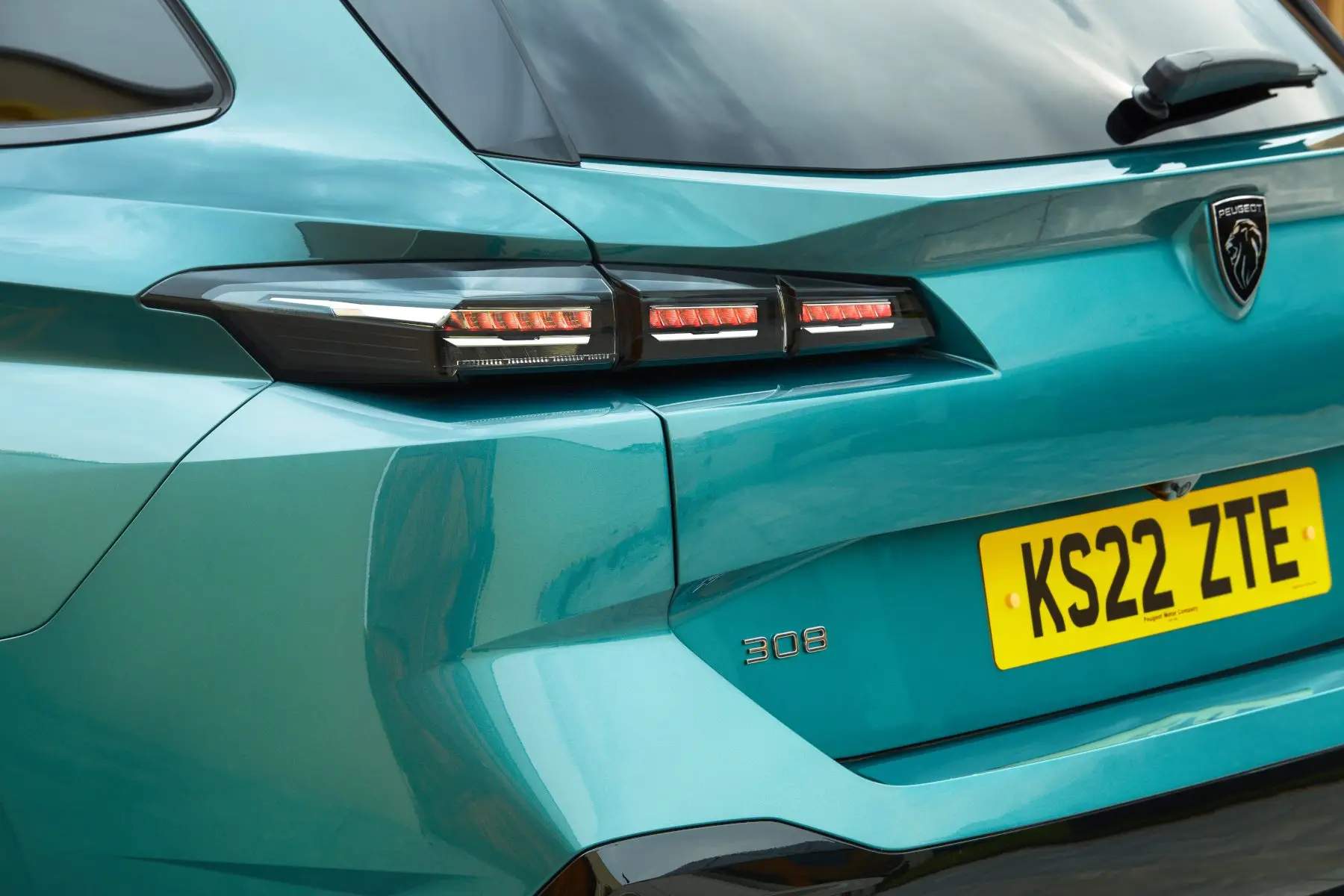
The Puretech 130 petrol engine is claimed to manage between 43.5mpg and 52.1mpg on the WLTP combined cycle, which is an identical lab-based figure to the hatchback. The extra 50kg or so added to the estate may be partially offset by better aerodynamics.
The BlueHDI 130 diesel does lose a tiny fraction of fuel efficiency in SW form though, oddly, This is claimed to manage between 56.9mpg and 65.0mpg - the latter figure 0.4mpg lower than the hatch.
The plug-in hybrid models claim identical MPG figures as the hatch, with the Hybrid 180 managing between 213 and 281mpg and the 225 claiming 213-266mpg. Those figures are simply for comparison to other PHEVs, as you'll only get near that figure on short journeys where you can use electric power the majority of the time. Do longer journeys with a depleted battery and they'll almost certainly be less efficient than the pure petrols and diesels.
If you're a company car user, it's important to note that the lesser-powered hybrid is rated for over 40 miles of electric range, whereas the most powerful manages 39 miles, meaning it's in a higher Benefit-in-Kind tax bracket.
How reliable is the Peugeot 308 SW?
The new Peugeot 308 SW has just arrived on the market so it's impossible for us to accurately assess its reliability. Much of the technology is new, although the engines are all familiar as they have been used elsewhere in Peugeot, Citroen, DS and Vauxhall models.
Peugeot didn't finish all that highly in the most recent Honest John Satisfaction Index, so it's difficult to say how it'll perform in the long-term. Having said that, modern cars don't generally cause as many issues as they used to, while the 308's engines are all well-proven by now.
Insurance groups and costs
Insurance group data for the Peugeot 308 SW has yet to be released, but we've no reason to believe it'll be dramatically more expensive to insure than the previous-generation model. Expect the plug-in hybrids to be the most expensive on account of their higher list prices, with the 1.2-litre petrol being the cheapest to insure.
VED car tax: What is the annual road tax on a Peugeot 308 SW?
The Peugeot 308 SW's range of efficient engines mean it shouldn't break the bank when it comes to road tax. Of course the hybrids save you money in this respect, but that doesn't offset the higher purchase price.
The first year rate for the 1.2-litre Puretech petrol is £190, rising to the £165 flat rate for the years following. The diesel model reduces that first-year rate to £170 because of its lower CO2 emissions.
The plug-in hybrids are noticeably cheaper in the first year, with both commanding a £10 annual rate, rising to the £165 flat rate after. We'd avoid the GT Premium model with the 225 Hybrid engine, though, as it just creeps over the £40,000 mark in list price terms, meaning you'll get clobbered for an extra £355 a year in tax for five years.
How much should you be paying for a Peugeot 308 SW?
"The Peugeot 308 SW commands a £1,200 premium spec-for-spec over its hatchback sibling, which puts it among the middle of the pack for family estates."
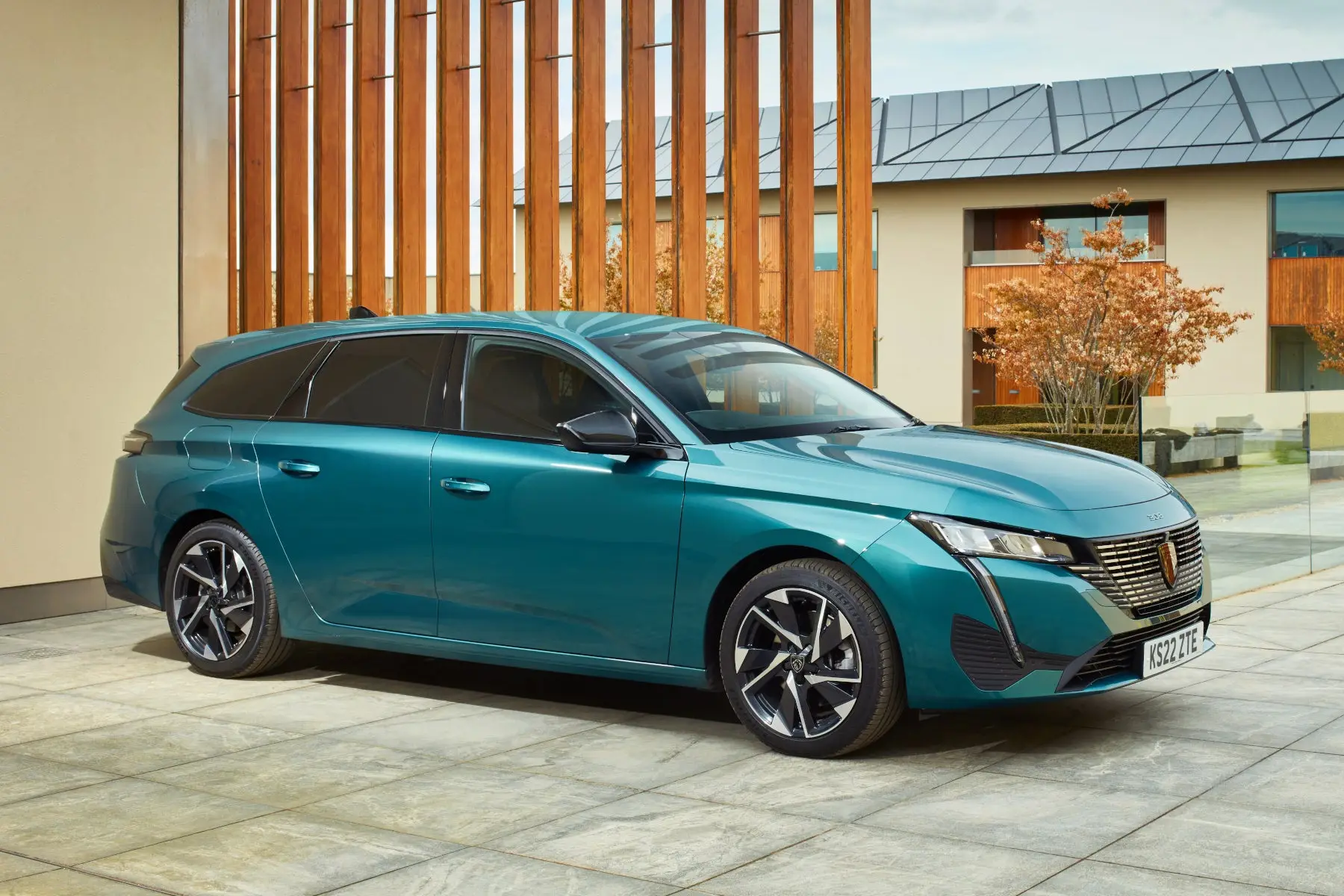
There might be cheaper family estates than the Peugeot 308 SW, but there's also pricier ones, and when you consider the amount of kit you get for the money even at the lower end of the line-up its reasonable value.
Prices start at £25,835 for the lowest-spec Active Premium model with the Puretech 130 engine, with the diesel model commanding a £1,400 premium. You'll need to splash out £27,685 for an Allure model, and £28,585 for an Allure Premium. The latter two trims are the ones to go for if you want the best-value blend of equipment and price, and expect them to be easier to sell on than the base trim.
The GT and GT Premium versions might look a bit flashier but the jump in list price is considerable: even the cheapest petrol version of the GT is £30,485, with the GT Premium at £32,085.
With comparable trims the 180PS Hybrid version commands a fairly hefty £7000 list price premium over the Puretech petrol, with the 225PS model (only offered in GT trim) requiring another £1400. That's quite the jump in price and will be mirrored with leasing costs.
Trim levels and standard equipment
Even the base model of the Peugeot 308 SW comes with a decent roster of kit, but we reckon you'll want to splash out for Allure or Allure Premium trim - those will be more desirable on the used market and that should reflect in leasing costs.
Base Active Premium trim comes with power-folding mirrors, 16-inch alloys, 'EcoLED' headlights and LED rear lights, auto lights and wipers, rear parking sensors, the full infotainment suite and auto emergency braking.
Allure models upgrade the wheel size to 17-inches, and introduce various other styling detail upgrades. You also get an AQS 3 air quality system, front parking sensors, tinted windows, a reversing camera, a drive mode selector, part synthetic leather trim, ambient lighting, high beam assist, upgraded LED running lights and sat-nav with live traffic updates. PHEV models get remote pre-heating and cooling, too.
Allure Premium trim adds the Drive Assist Pack with adaptive cruise control, rear-cross traffic alert and blind spot detection, while keyless entry and start, wireless phone charging and wireless Apple CarPlay and Android Auto also features.
Stepping up to GT trim nets you an enhanced air quality system, 3D digital instruments, a heated steering wheel, the Driver Sport Pack, a green stitched leather steering wheel, Alcantara and faux-leather trim, black headlining, aluminium door sills, exterior styling upgrades, 18-inch alloys, full Matrix LED headlights and upgraded 'Claw Effect' LED rear lights.
Top-of-the-line GT Premium trim further adds Lane Positioning Assist, two-tone 18-inch alloys, a 360-degree parking camera and self-parking aid, an electric tailgate, upgraded front seats with electric adjustment on the driver's side and heating and massaging for both front seats, electric lumbar adjustment and a Focal Premium sound system.
Ask the heycar experts: common questions
How big is the boot on a Peugeot 308 SW?
What does SW mean on the Peugeot 308 SW?
Is the Peugeot 308 SW reliable?
Other popular reviews
Stay up to speed with great offers plus the latest car news and reviews
Keep me updated by email with the latest advice, news and offers from heycar.
By submitting you agree to our privacy policy


